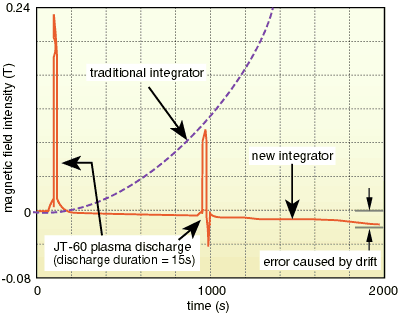An integral means the accumulation of signals in a certain time interval
and is one of the fundamental quantities in an automatic feedback control
circuit. However, it is usually believed that accuracy and/or reliability
of integrals are poor in the case of longer time intervals due to both
fluctuation signals inside the circuit and some disturbances from external
circuits.
Measurement of the magnetic field intensity with high accuracy is necessary
and inevitable for a fusion reactor, in which fusion particles are confined
by the magnetic field. The magnetic field intensity is usually measured
by an integral of the signals from the magnetic probe which detects
the temporal variations of the magnetic field. It is needed to measure
the magnetic field over 2,000 s in ITER. We have developed an integrator
using modern digital technology. A schematic diagram of the new integrator
is shown in Fig. 2-13. Compensation for steady noises inside the circuit
is needed, because the magnetic probe suffers from noise signals. Furthermore,
fully developed studies have been made for the temperature control of
elements, insulations in printing bases, earthing methods, protection
for over-voltage signals, resetting of the analog-digital converter
and etc. Comparison data between the new type integrator and a traditional
one are shown in Fig. 2-14. In the case of a traditional integrator,
the error (magnetic field intensity caused by drift) increases continuously.
On the other hand, in the case of the new method, the error is negligible
for about 2,000 s. |

